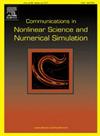一种新颖的用于非线性Klein-Gordon方程超收敛分析的低阶H1-Galerkin混合有限元框架
IF 3.4
2区 数学
Q1 MATHEMATICS, APPLIED
Communications in Nonlinear Science and Numerical Simulation
Pub Date : 2025-05-09
DOI:10.1016/j.cnsns.2025.108912
引用次数: 0
摘要
利用低阶双线性单元与零阶Raviart-Thomas单元(Q11+Q10×Q01)配对,探索求解非线性Klein-Gordon方程的H1-Galerkin混合有限元法(MFEM)。严格地建立了离散系统解的存在唯一性。利用双线性元的积分恒等式,导出了连接插值和Riesz投影的超收敛估计。在半离散框架中,主变量u在H1范数和辅助变量p→=∇u在H(div;Ω)范数分别实现了O(h2)阶的超密性。此外,通过基于插值的后处理方法获得了全局超收敛结果。对于完全离散的公式,我们引入了一个二阶格式,它表现出O阶(h2+τ2)的超接近性,其中h表示细分参数,τ表示时间增量。最后,通过数值实验验证了理论结果的有效性。本文章由计算机程序翻译,如有差异,请以英文原文为准。
An innovative low-order H1-Galerkin mixed finite element framework for superconvergence analysis in nonlinear Klein–Gordon equations
A -Galerkin mixed finite element method (MFEM) is explored for solving the nonlinear Klein–Gordon equation, utilizing the lower-order bilinear element paired with the zero-order Raviart–Thomas element . The existence and uniqueness of the solutions for the discretized system are rigorously established. By exploiting the integral identity associated with the bilinear element, a superconvergence estimate linking the interpolation and the Riesz projection is derived. In the semi-discrete framework, the supercloseness of order is achieved for the primary variable in the norm and for the auxiliary variable in the norm, respectively. Additionally, global superconvergence results are obtained through an interpolation-based postprocessing method. Moving to the fully discrete formulation, a second-order scheme is introduced, which exhibits the supercloseness of order , where represents the subdivision parameter and the time increment. Finally, the numerical experiments are conducted to confirm the validity of the theoretical findings.
求助全文
通过发布文献求助,成功后即可免费获取论文全文。
去求助
来源期刊

Communications in Nonlinear Science and Numerical Simulation
MATHEMATICS, APPLIED-MATHEMATICS, INTERDISCIPLINARY APPLICATIONS
CiteScore
6.80
自引率
7.70%
发文量
378
审稿时长
78 days
期刊介绍:
The journal publishes original research findings on experimental observation, mathematical modeling, theoretical analysis and numerical simulation, for more accurate description, better prediction or novel application, of nonlinear phenomena in science and engineering. It offers a venue for researchers to make rapid exchange of ideas and techniques in nonlinear science and complexity.
The submission of manuscripts with cross-disciplinary approaches in nonlinear science and complexity is particularly encouraged.
Topics of interest:
Nonlinear differential or delay equations, Lie group analysis and asymptotic methods, Discontinuous systems, Fractals, Fractional calculus and dynamics, Nonlinear effects in quantum mechanics, Nonlinear stochastic processes, Experimental nonlinear science, Time-series and signal analysis, Computational methods and simulations in nonlinear science and engineering, Control of dynamical systems, Synchronization, Lyapunov analysis, High-dimensional chaos and turbulence, Chaos in Hamiltonian systems, Integrable systems and solitons, Collective behavior in many-body systems, Biological physics and networks, Nonlinear mechanical systems, Complex systems and complexity.
No length limitation for contributions is set, but only concisely written manuscripts are published. Brief papers are published on the basis of Rapid Communications. Discussions of previously published papers are welcome.
 求助内容:
求助内容: 应助结果提醒方式:
应助结果提醒方式:


